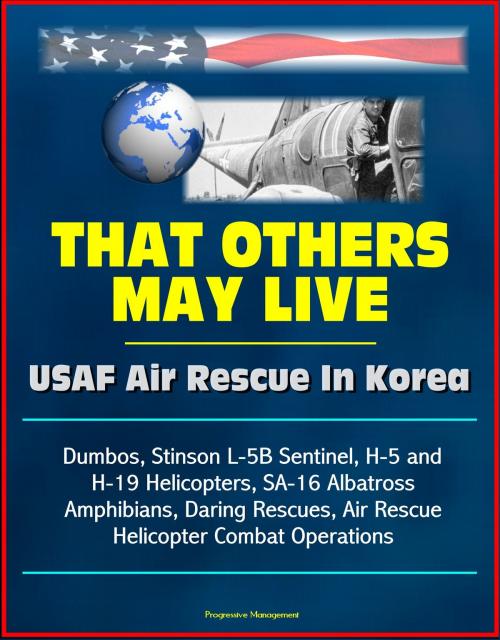That Others May Live: USAF Air Rescue In Korea - Dumbos, Stinson L-5B Sentinel, H-5 and H-19 Helicopters, SA-16 Albatross Amphibians, Daring Rescues, Air Rescue Helicopter Combat Operations
Nonfiction, History, Asian, Korean War, Military, Aviation| Author: | Progressive Management | ISBN: | 9781310750137 |
| Publisher: | Progressive Management | Publication: | August 14, 2015 |
| Imprint: | Smashwords Edition | Language: | English |
| Author: | Progressive Management |
| ISBN: | 9781310750137 |
| Publisher: | Progressive Management |
| Publication: | August 14, 2015 |
| Imprint: | Smashwords Edition |
| Language: | English |
Professionally converted for accurate flowing-text e-book format reproduction, this Air Force publication tells the story of air rescue in the Korean War. When the Korean War began in June 1950, the United States Air Force's Air Rescue Service was a fledgling organization possessing a variety of aircraft types, most having seen service during World War II. The concept of using helicopters and amphibious fixed-wing aircraft to rescue airmen downed behind enemy lines or in hostile waters had gained little consideration by the Air Force and was largely unproven. But by the fall of 1950 the 3d Air Rescue Squadron had begun to write a new chapter in the history of air power, and by July 1953, when the armistice was signed in Korea, air rescue had become established as an integral part of U.S. fighting forces. Although the H-5 and H-19 helicopters and SA-16 amphibians gained attention worldwide by virtue of countless daring rescues performed throughout the war, lesser known aircraft such as the L-5, SC-47, SB-17, and SB-29 also played important roles in building the U.S. Air Force's overall air rescue capability in the Korean War theater.
Rotary-wing aircraft operations to rescue downed airmen began in the China-Burma-India Theater late in the Second World War when U.S. Army Air Forces emergency rescue squadrons used Sikorsky R-6 helicopters to perform a few dozen pickups. Flying over jungle and mountainous terrain, aircrews returned injured personnel to safety within hours, instead of the days or even weeks that a ground party required. Considering that the first practical rotary-wing aircraft, Igor Sikorsky's VS-300, had flown only a few years earlier in 1941, the limited accomplishments of helicopters heralded the birth of a new technology with immense potential for military applications, notably, medical evacuation and aircrew rescue.
Less than five years after World War II ended, a conflict erupted in which helicopters became recognized as indispensable to warfare. Between 1950 and 1953 in the Korean War theater, the Air Rescue Service (ARSvc) operated the SA-16 amphibian, L-5 liaison plane, SC-47 transport, SB-17 and SB-29 bombers, and Sikorsky-built H-5 and H-19 helicopters. Representing technology only a decade old, the lifesaving medical evacuation and rescue achievements of these Sikorsky helicopters captured worldwide attention. Helicopters of all the military services proved their worth throughout the war by evacuating some 25,000 personnel, mostly wounded soldiers, many of whom would not have survived the lengthy, tortuous jeep or truck trip over primitive roads required to reach a hospital. Helicopters of the ARSvc's 3d Air Rescue Squadron (ARS) contributed to that record in what was for them a secondary role, evacuating at least 7,000 wounded soldiers over the duration of the conflict. In its primary mission, ARSvc helicopters rescued nearly 1,000 U.S./UN personnel from behind enemy lines.
Although 3d ARS helicopters were the only ones among U.S./UN forces with the primary mission of picking up downed airmen, rotary-wing aircraft of other U.S. armed forces performed a limited amount of aircrew rescue work. Marine Observation Squadron Six, which flew the HO3S-1, the Marine Corps version of the U.S. Air Force's (USAF) H-5 helicopter, rescued downed airmen and performed medical evacuations, observation and spotting of artillery fire, command and staff flights, and reconnaissance. During late 1950, Marine helicopters rescued at least twenty-three aircrew members from behind enemy lines, while over a slightly longer period, 3d ARS helicopters achieved more than seventy-two behind-the-lines pickups. U.S. Navy helicopters, employed primarily in mine sweeping and in observing and spotting naval gunfire, sometimes picked up pilots who had ditched at sea. U.S. Army utility helicopters may also have performed several aircrew rescues.
Professionally converted for accurate flowing-text e-book format reproduction, this Air Force publication tells the story of air rescue in the Korean War. When the Korean War began in June 1950, the United States Air Force's Air Rescue Service was a fledgling organization possessing a variety of aircraft types, most having seen service during World War II. The concept of using helicopters and amphibious fixed-wing aircraft to rescue airmen downed behind enemy lines or in hostile waters had gained little consideration by the Air Force and was largely unproven. But by the fall of 1950 the 3d Air Rescue Squadron had begun to write a new chapter in the history of air power, and by July 1953, when the armistice was signed in Korea, air rescue had become established as an integral part of U.S. fighting forces. Although the H-5 and H-19 helicopters and SA-16 amphibians gained attention worldwide by virtue of countless daring rescues performed throughout the war, lesser known aircraft such as the L-5, SC-47, SB-17, and SB-29 also played important roles in building the U.S. Air Force's overall air rescue capability in the Korean War theater.
Rotary-wing aircraft operations to rescue downed airmen began in the China-Burma-India Theater late in the Second World War when U.S. Army Air Forces emergency rescue squadrons used Sikorsky R-6 helicopters to perform a few dozen pickups. Flying over jungle and mountainous terrain, aircrews returned injured personnel to safety within hours, instead of the days or even weeks that a ground party required. Considering that the first practical rotary-wing aircraft, Igor Sikorsky's VS-300, had flown only a few years earlier in 1941, the limited accomplishments of helicopters heralded the birth of a new technology with immense potential for military applications, notably, medical evacuation and aircrew rescue.
Less than five years after World War II ended, a conflict erupted in which helicopters became recognized as indispensable to warfare. Between 1950 and 1953 in the Korean War theater, the Air Rescue Service (ARSvc) operated the SA-16 amphibian, L-5 liaison plane, SC-47 transport, SB-17 and SB-29 bombers, and Sikorsky-built H-5 and H-19 helicopters. Representing technology only a decade old, the lifesaving medical evacuation and rescue achievements of these Sikorsky helicopters captured worldwide attention. Helicopters of all the military services proved their worth throughout the war by evacuating some 25,000 personnel, mostly wounded soldiers, many of whom would not have survived the lengthy, tortuous jeep or truck trip over primitive roads required to reach a hospital. Helicopters of the ARSvc's 3d Air Rescue Squadron (ARS) contributed to that record in what was for them a secondary role, evacuating at least 7,000 wounded soldiers over the duration of the conflict. In its primary mission, ARSvc helicopters rescued nearly 1,000 U.S./UN personnel from behind enemy lines.
Although 3d ARS helicopters were the only ones among U.S./UN forces with the primary mission of picking up downed airmen, rotary-wing aircraft of other U.S. armed forces performed a limited amount of aircrew rescue work. Marine Observation Squadron Six, which flew the HO3S-1, the Marine Corps version of the U.S. Air Force's (USAF) H-5 helicopter, rescued downed airmen and performed medical evacuations, observation and spotting of artillery fire, command and staff flights, and reconnaissance. During late 1950, Marine helicopters rescued at least twenty-three aircrew members from behind enemy lines, while over a slightly longer period, 3d ARS helicopters achieved more than seventy-two behind-the-lines pickups. U.S. Navy helicopters, employed primarily in mine sweeping and in observing and spotting naval gunfire, sometimes picked up pilots who had ditched at sea. U.S. Army utility helicopters may also have performed several aircrew rescues.















